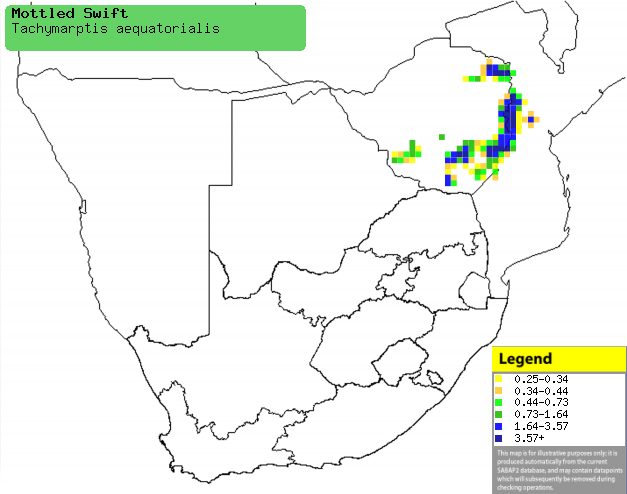|
Tachymarptis aequatorialis
(Mottled swift)
[= Apus aequatorialis]
Bontwindswael [Afrikaans]; Geschubde berggierzwaluw [Dutch];
Martinet marbré [French]; Schuppensegler [German]; Andorinhão-malhado
[Portuguese]
Life
> Eukaryotes >
Opisthokonta
> Metazoa (animals) >
Bilateria >
Deuterostomia > Chordata >
Craniata > Vertebrata (vertebrates) > Gnathostomata (jawed
vertebrates) > Teleostomi (teleost fish) > Osteichthyes (bony fish) > Class:
Sarcopterygii (lobe-finned
fish) > Stegocephalia (terrestrial
vertebrates) > Tetrapoda
(four-legged vertebrates) > Reptiliomorpha > Amniota >
Reptilia (reptiles) >
Romeriida > Diapsida > Archosauromorpha > Archosauria >
Dinosauria
(dinosaurs) > Saurischia > Theropoda (bipedal predatory dinosaurs) >
Coelurosauria > Maniraptora > Aves (birds) > Order: Apodiformes >
Family: Apodidae
Distribution and habitat
Occurs in patches of West Africa as well as the area from
Ethiopia south through Uganda, Kenya, Tanzania and Malawi to southern Africa.
Within southern Africa it is
locally fairly common in Zimbabwe and adjacent Mozambique, generally preferring
areas with plenty of granite outcrops.
|
 |
|
Distribution of Mottled swift in southern Africa,
based on statistical smoothing of the records from first SA Bird Atlas
Project (©
Animal Demography unit, University of
Cape Town; smoothing by Birgit Erni and Francesca Little). Colours range
from dark blue (most common) through to yellow (least common). |
Predators and parasites
Movements and migrations
Little known, but probably resident and
sedentary.
Food
Mainly eats flying insects, foraging both close to the
ground and at higher altitudes. The following food items have been recorded
in its diet:
Breeding
- Monogamous, usually nesting in colonies of approximately 25 nests, with
each pair fighting vigorously for control of a nest site.
- The nest is a strongly-built half cup with a rim of feathers, seeds and
leaves, glued together with saliva and typically placed beneath an overhang
or in the vertical crack of a cave.
- Egg-laying season is from June-January, peaking from June-September.
- It lays 1-3 eggs, which are incubated by both sexes.
- Little is known about the chicks, besides that they probably learn to
fly at about 28 days old.
Threats
Not threatened.
References
-
Hockey PAR, Dean WRJ and Ryan PG 2005. Roberts
- Birds of southern Africa, VIIth ed. The Trustees of the John Voelcker
Bird Book Fund, Cape Town.
|
